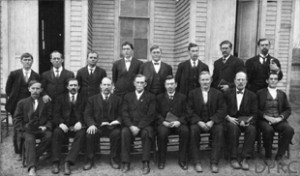Sharing the Load: The First State Overseers
When the sixth General Assembly met in Cleveland, Tennessee, January 3-8, 1911, the Church of God had grown to fifty-eight churches, 107 ministers, and 1,855 members. Despite this growth, General Overseer A.J. Tomlinson expressed disappointment.
Tomlinson lamented to the delegates that the more recent increase “has not been as great as we had hoped and has not reached the same proportion of last year.” He continued, “Owing to the scattered positions the churches occupy, I have not been able to visit them as perhaps I should…. Some of the churches have been neglected on account of my inability to supply them with pastors, although they begged for assistance. Many calls for ministers have been refused simply because of a shortage.”

Three of the original state overseers selected in 1911 are in this photo of ministers taken in 1910. W.F. Bryant, standing second from left, overseer of Tennessee; V.W. Kennedy, standing fourth from left, overseer of Alabama; and C.R. Curtis, sitting far right, overseer of North Carolina. Other state overseers appointed in 1911 included Sam C. Perry, Kentucky; J.J. Lowman, Virginia; H.W. McArthur, Georgia; J.A. Giddens, Florida; and R.M. Evans, Bahama Islands.
The General Assembly had selected Tomlinson as general moderator two years earlier. In addition to moderating the Assemblies, the office was given the responsibility of issuing ministerial credentials, keeping ministerial records, assisting in appointing pastors, and caring for the general interests of the churches. The next year the Assembly changed the name of his office from general moderator to general overseer.
But by 1911, it was clear that the work was too much for one person alone. Church of God congregations were now established in six states and one foreign country. General Overseer Tomlinson reported that he expected the movement to soon be in an additional six states, including California, as well as the nation of Cuba. Tomlinson declared, “The work has grown to such a proportion now that there is a demand for a better system. As to just what should be done, and the form it should assume, I leave to the more able minds of this Assembly. The plans of the Bible should be sought out and followed, and yet much is left in which for us to exercise our own judgment.”
The sixth General Assembly discussed several matters at length including “The Teachings” of the Church and the need for a Bible Training School to prepare Christian workers. On the last day of the Assembly, delegates considered the advisability of appointing overseers for each state and concluded that this would be in “perfect harmony with the teachings of Scripture.” They immediately selected overseers for seven states and the Bahamas.
The responsibilities of the newly appointed overseers were to give general oversight of their state including an evangelistic campaign each year; to supply every church with a pastor; to keep records of all ministers and churches within the state, including the number of members in each church; and to provide a year-end report to the general overseer.
In the early years state overseers sometimes changed as often as every year. Then in 1944 the General Assembly limited the state overseer’s tenure to four consecutive years in one state. This was later extended to twelve years with sufficient support of the state’s ministers. In 2000, the sixty-eighth General Assembly gave state overseers the choice to use the title administrative bishop, which is now the custom of many overseers.
———————————————————-
This article was written by Church of God Historian David G. Roebuck, Ph.D., who is director of the Dixon Pentecostal Research Center and assistant professor of the history of Christianity at Lee University. This “Church of God Chronicles” was first published in the August 2008 Church of God Evangel.




